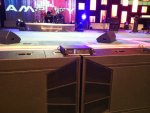Tom and Ivan were kind enough to feed my quest for the ultimate subwoofer. Flyable, folded horn rather than tapped, very high output and impact, output to below 30Hz, 22.5 x 45 x 60 inches. We are in Tulsa at a Christian worship leadership conference, with nightly concerts, with the first two subs off the line delivered here. A FP14000 provided the power. The room seats 4,500 or so, with a dozen Turbo 21's and dual 18's (total, not each).
Long story short, after tuning the system, we decided to fire up the subs for fun, with no intention of actually using them. Jaws hit the floor - and then turned them up full. We ended up using only that pair of DBH-218-LC's for the whole week. Needless to say, we were all very pleasantly surprised, and we're planning on installing 4 there before long. I figured 8 would be needed, flown mono cardioid, for Evan levels of bass with even coverage and impact.
If I can get to a larger room or better, outdoors, I'll try to post some Smaart traces.
Overall, if you're looking at max performance subs, these should be on your short list.
Long story short, after tuning the system, we decided to fire up the subs for fun, with no intention of actually using them. Jaws hit the floor - and then turned them up full. We ended up using only that pair of DBH-218-LC's for the whole week. Needless to say, we were all very pleasantly surprised, and we're planning on installing 4 there before long. I figured 8 would be needed, flown mono cardioid, for Evan levels of bass with even coverage and impact.
If I can get to a larger room or better, outdoors, I'll try to post some Smaart traces.
Overall, if you're looking at max performance subs, these should be on your short list.


